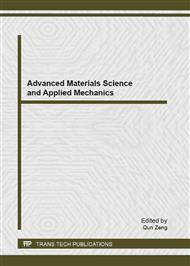[1]
Shelvin, S.S., Cermets ed. J.R. Tinkelpaugh and W.B. Grandall. 1966, New York: Reinold Publ.Corp.
Google Scholar
[2]
Kaplan, W.D. and A. Avishai, Ceramic matrix composites (Microstructure, properties and applications), ed. I.M. Low. 2006, Cambridge, England: Woodhead Publ.Ltd.
Google Scholar
[3]
Pugacheva, E.V., et al., SHS-Produced Intermetallides as Catalysts for Deep Oxidation of Carbon Monoxide and Hydrocarbons. Int. J. Self-Prop. High-Temp. Syn., 2010. 19(1): p.65.
DOI: 10.3103/s1061386210010115
Google Scholar
[4]
Arkatova, L.A., The deposition of coke during carbon dioxide reforming of methane over intermetallides. Catalysis Today, 2010. 157(1-4): p.170.
DOI: 10.1016/j.cattod.2010.03.003
Google Scholar
[5]
Pavlova, S., et al., Monolith composite catalysts based on ceramometals for partial oxidation of hydrocarbons to synthesis gas. Natural Gas Conversion Vii, 2004. 147: p.223.
DOI: 10.1016/s0167-2991(04)80055-7
Google Scholar
[6]
Tikhov, S.F., et al., Hydrogenated Zr-Fe alloys encapsulated in Al2O3/Al matrix as catalysts for Fischer-Tropsch synthesis. Natural Gas Conversion Vii, 2004. 147: p.337.
DOI: 10.1016/s0167-2991(04)80074-0
Google Scholar
[7]
Khodakov, A.Y., W. Chu, and P. Fongarland, Advances in the Development of Novel Cobalt Fischer−Tropsch Catalysts for Synthesis of Long-Chain Hydrocarbons and Clean Fuels. Chemical Reviews, 2007. 107(5): p.1692.
DOI: 10.1021/cr050972v
Google Scholar
[8]
Tikhov, S.F., et al., Porous ceramic matrix Al2O3/Al composites as supports and precursors for catalysts and permeable materials, in Metal, ceramic and polymeric composites for various uses, J. Cuppoletti, Editor. 2011, INTECH: Croatia. p.195.
DOI: 10.5772/19031
Google Scholar
[9]
Bolotov, V.A., et al., Pyrolysis of Heavy Hydrocarbons Under Microwave Heating of Catalysts and Adsorbents. Journal of Microwave Power and Electromagnetic Energy, 2012. 46(1): p.39.
DOI: 10.1080/08327823.2012.11689822
Google Scholar
[10]
Patent, USA, N 5462903, (1955)
Google Scholar
[11]
Aharon, O., et al., Residual stresses and magnetic properties of alumina-nickel nanocomposites. Scripta Materialia, 2004. 50(9): p.1209.
DOI: 10.1016/j.scriptamat.2004.02.006
Google Scholar
[12]
Lu, T. and Y. Pan, Combustion synthesis of ferromagnetic Al2O3-based cermets in thermal explosion mode. J. Mater. Sci., 2010. 45: p.5923.
DOI: 10.1007/s10853-010-4672-4
Google Scholar
[13]
Portnoi, V.K., K.V. Tret'yakov, and V.I. Fadeeva, Structural transformations during the mechanochemical synthesis and heating of Co-Al alloys. Inorganic Materials, 2004. 40(9): p.937.
DOI: 10.1023/b:inma.0000041325.46591.db
Google Scholar
[14]
Kimura, Y., et al., Microstructure Control and Mechanical-Properties of Binary Co-Al Alloys Based on B2 Intermetallic Compound Coal. Materials Transactions Jim, 1994. 35(3): p.182.
DOI: 10.2320/matertrans1989.35.182
Google Scholar
[15]
Hosseini, S.N., et al., Thermodynamic Aspects of Nanostructured CoAl Intermetallic Compound during Mechanical Alloying. Journal of Materials Science & Technology, 2011. 27(7): p.601.
DOI: 10.1016/s1005-0302(11)60114-x
Google Scholar
[16]
Tikhov, S., et al., Design of composite porous cermets synthesized by hydrothermal treatment of CrAl powder followed by calcination. Journal of Materials Science, 2010. 45(12): p.3160.
DOI: 10.1007/s10853-010-4322-x
Google Scholar
[17]
Andreev, A., et al., Formation of Micro, Nano and Atomic-Level Structure of CoAlO/Co-Al Cermets Prepared by Mechanical Alloying. J. Mater. Sci. Eng. A, 2012. 2(2): p.121.
Google Scholar
[18]
Goldstein, J., et al., Scanning Electron Microscopy in X-Ray Microanalysis. 3rd ed. 2008, New York: Springer.
Google Scholar
[19]
INCA Energy Operation Manual, O.I.A., UK, 2004.
Google Scholar
[20]
Sort, J., et al., Role of stacking faults in the structural and magnetic properties of ball-milled cobalt Phys. Rev. B, 2003. 68: p.014421.
Google Scholar
[21]
Koi, Y. and A. Tsujimura, NMR of Co59 in Ferromagnetic Cobalt Alloys. J. Phys. Soc. Jpn., 1961. 16: p.574.
Google Scholar
[22]
Tikhov, S.F., et al., Physicochemical principles of the synthesis of porous composite materials through the hydrothermal oxidation of aluminum powder. Kinet Catal+, 2005. 46(5): p.641.
DOI: 10.1007/s10975-005-0120-x
Google Scholar
[23]
Zolotovskii, B., et al., Development of the technology and production of spherical alumina for catalysts supports and adsorbents. Russian Journal of Applied Chemistry, 1997. 70(1): p.299.
Google Scholar
[24]
Tikhov, S.F., et al., Synthesis of alumina through hydrothermal oxidation of aluminum powder conjugated with surfactant-directed oriented growth Mat. Res. In. online, 2005. 9: p.431.
Google Scholar
[25]
Chernousov, Y.D., et al., Characteristics of a chemical reactor that is a loaded microwave resonator. Journal of Communications Technology and Electronics, 2009. 54(2): p.231.
Google Scholar
[26]
Gossard, A.C. and A.M. Portis, Observation of nuclear resonanse in a ferromagnet. Phys. Rev. Lett., 1959. 3(4): p.164.
Google Scholar
[27]
Gossard, A.C., et al., Ferromagnetic Nuclear Resonance of Single-Domain Cobalt Particles. Physical Review, 1965. 138(5A): p. A1415.
DOI: 10.1103/physrev.138.a1415
Google Scholar
[28]
Koi, Y., A. Tsujimura, and T. Kushida, NMR of Co59 in Ferromagnetic Hexagonal Cobalt Metal. J. Phys. Soc. Jpn., 1960. 15: p.2100.
DOI: 10.1143/jpsj.15.2100
Google Scholar
[29]
Kawakami, M., T. Hihara, and Y. Koi, The Co59 Nuclear Magnetic Resonance in Hexagonal Cobalt. J. Phys. Soc. Jpn., 1972. 33(6): p.1591.
Google Scholar
[30]
Hardy, W.A., Nuclear Resonances in Cubic, Hexagonal, and Mixed Phase Cobalt Powders and Thin Films. J. Appl. Phys., 1961. 32(3): p. S122.
DOI: 10.1063/1.2000372
Google Scholar
[31]
Panissod, P., et al., NMR analysis of buried metallic interfaces. Hyperfine Interact., 1996. 97-98: p.75.
DOI: 10.1007/bf02150169
Google Scholar
[32]
Panissod, P., Structural and magnetic investigations of ferromagnets by NMR. Application to magnetic metallic multilayers, in Frontiers in Magnetism of Reduced Dimension systems, V.G. Bar'yakhtar, P.E. Wigen, and N.A. Lesnik, Editors. 1998, Kluwer Academic. p.225.
DOI: 10.1007/978-94-011-5004-0_10
Google Scholar
[33]
Bibring, H. and F. Sebilleau, Rev. Met., 1955. 52.
Google Scholar
[34]
Wieldraaijer, H., W.J.M. de Jonge, and J.T. Kohlhepp, Electric-field gradients in thin face-centered-tetragonal Co films observed by nuclear magnetic resonance. Physical Review B, 2005. 72(15): p.155409.
DOI: 10.1103/physrevb.72.155409
Google Scholar
[35]
Bakhmutov, V.I., et al., Supermicroporous silica-based SiO2-Al2O3-NiO materials: Solid-state NMR, NMR relaxation and magnetic susceptibility. Microporous and Mesoporous Materials, 2009. 118(1-3): p.78.
DOI: 10.1016/j.micromeso.2008.08.023
Google Scholar
[36]
Cowan, D.L. and L.W. Anderson, Nuclear Magnetic Resonance of 61Ni in Nickel Metal. Physical Review, 1965. 139(2A): p. A424.
Google Scholar


